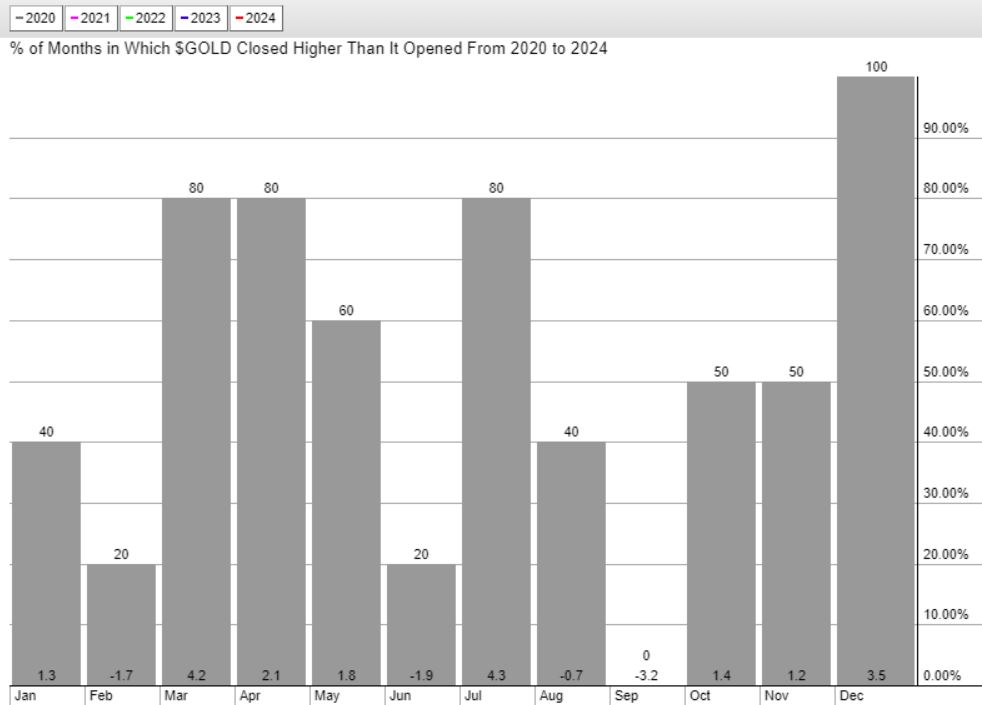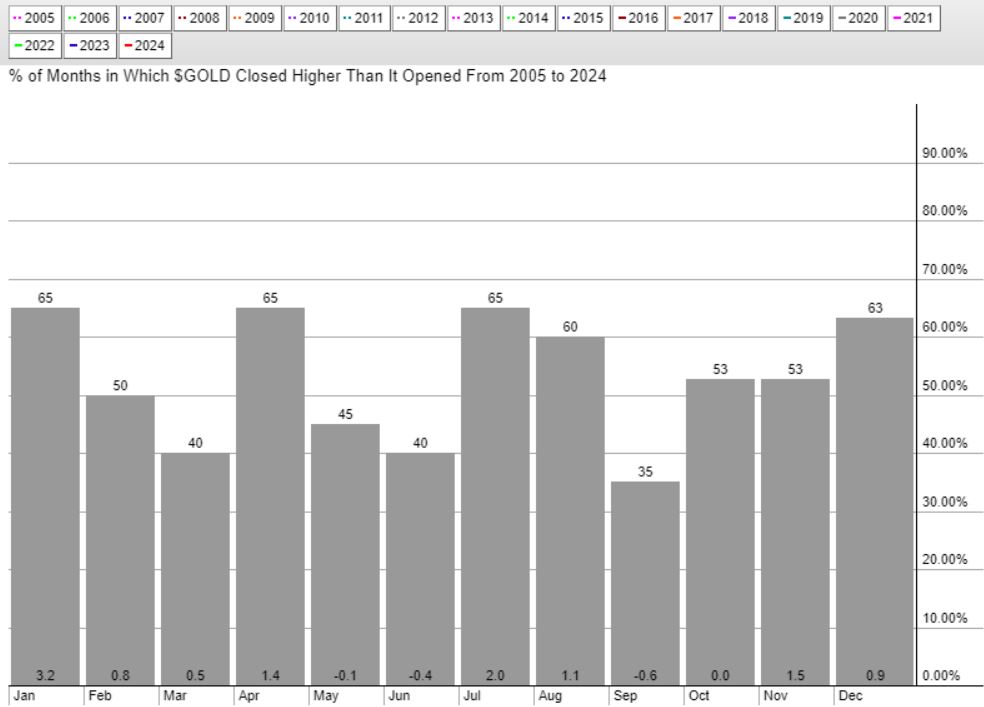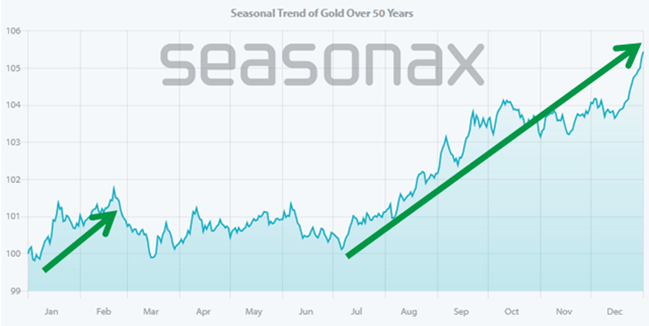The seasonality of the gold price remains consistent and reliable. September is usually the weakest month, and from mid-September 2024 we will move into the strongest period for gold. This marks an excellent opportunity for investors in 2024, as the most favorable season for gold begins.
RELATED – Read our latest insights on the 2025 gold price forecast.
Gold continues to make ATH, while silver is more than 40% below ATH. This makes for a very interesting phase in the new gold bull market. A thorough study of both metals is warranted as both offer different types of capabilities. One of these is the lagging price behavior of silver. That is why we prefer silver as a precious metal to buy in 2025.
At the same time, gold also has opportunities as it has entered its new gold bull market. According to our calculations, the gold bull market started on March 4, 2024.
That’s where the seasonality of the gold price comes into play.
Understanding gold’s seasonal trends provides valuable insights for investors looking to optimize their entry and exit points into the gold market.
By examining different time frames – from the past five years to a fifty-year historical perspective – we can identify consistent patterns, seasonal strengths and periods of caution.
This article examines the seasonal trends in gold using various charts, covering short-, medium- and long-term data. One benchmark we will include is the comparison with the seasonality of the silver price.
We also highlight the specific impact of September as a challenging month for goldjust when the market is transitioning into the most favorable period.
Gold price seasonality: high-level insights
Gold, as a valuable commodity and investment, has well-established seasonal patterns that can help investors make informed decisions.
A 50-year analysis shows that gold typically experiences its strongest gains in the second half of the year, starting from 2015 July 6 and around peaks February 21 of the following year.
Thanks to the founder of Seasonax Dimitri Speck (follow-up X).
This period has historically produced average profits of 6.96% Unpleasant 11.27%which significantly outperforms the average annual profit of 5.18% over 50 years.
RELATED – 50 Year Gold Price Chart
However, the first half of the year is less consistent, with periods of both strength and weakness. September in particular is emerging as a challenging month, often the weakest month for gold, characterized by lower performance and increased volatility.
When we examine the past five years (2020-2024), we see these long-term patterns reflected and amplified, especially the strength from October through February.
However, the five-year data shows variability in months like March and April, which contrasts with some of the mid-year trends seen in the fifty-year analysis. This comparison highlights both the reliability and nuances of gold’s seasonal trends, providing a roadmap for gold investments throughout the year.
Seasonality of the gold price in the last 5 years: 2020-2024
This chart shows gold’s monthly performance from 2020 to 2024, highlighting the percentage of months in which gold closed higher than it opened.
- Strong performance in January and August: The data shows consistent peaks in January and August, indicating that these months have been favorable for gold investors in recent years.
- Mid-year weakness in March and April: March and April show relatively weaker performance, indicating potential periods of consolidation or market correction.
- Strong in November and December: The months of November and December also show strong performance, indicating favorable year-end conditions for gold.
Key insights: The recent 5-year trend highlights January, August, November and December as strong months for potential gains in gold, while March and April show more variability and caution is warranted.


Seasonality of the gold price over the past 20 years: 2005-2024
This chart covers a 20-year period from 2005 to 2024 and provides a longer-term perspective on gold’s seasonality.
- Consistently strong months: January, August and November: Similar to the recent five-year data, January, August and November remain strong months, showing a greater likelihood of positive returns.
- Weakness in February and March: February and March have lower chances of positive returns, suggesting that these months may face seasonal headwinds.
- Stability at mid-year and strength at the end of the year: The period from April to July shows more stability without significant peaks or valleys, while the end of the year (November and December) remains strong.
Key insights: The 20-year trend is consistent with recent data, highlighting January, August and November as key months for potential gains. It also reinforces the need to be cautious in February and March, where historical performance has been weaker.


Seasonality of the gold price over 50 years
The 50-year seasonal chart of Seasonax.com provides a comprehensive historical analysis of gold prices throughout the year.
- Good luck at the beginning of the year: Gold generally performs well in January and February, indicating strong seasonality in the first quarter.
- Mid-year fluctuations: After a strong start, the gold price fluctuates from March through July, seeing a mix of moderate gains and some periods of weakness. As highlighted by Seasonax, there is generally no significant average return for investors before July 6.
- Precise timing of the seasonal increase: According to Seasonax, the most noticeable seasonal increase begins July 6 and continues to reach a seasonal high February 21 of the following year. During this period, gold’s gains are average 6.96% And 11.27% per year, which is more than double the average annual profit of 5.18% during the 50 years.
- September as the weakest month: September is historically one of the weakest months for gold, with often lower performance and increased volatility. This suggests that investors should be cautious during this period.
- Last year’s rally: From August onwards, especially in November and December, gold tends to recover, making the end of the year a consistently favorable period for gold investors.
Key insights: The 50-year trend confirms strength in January, August and November, in line with shorter-term data. The period from July 6 to February 21 highlights the most profitable time frame for gold investors.


The seasonality of the gold price over the past five years compared to previous periods
Performance shifts in key months
- Consistently strong months – January, August and November: Across all time periods – 5 years, 20 years and 50 years – January, August and November consistently emerge as strong months for gold. This consistency suggests that these months are determined by recurring factors, such as increased investment demand, economic cycles or geopolitical influences. Seasonax’s insight into the specific start of a strong period from July 6 reinforces that this trend is well-rooted in historical data.
- Weaker performance in February and March: Both the 20-year and 50-year data show that February and March are weaker months for gold, which is in line with the recent 5-year trend. This consistency indicates that these months may face seasonal headwinds, possibly due to market corrections or changing investor sentiment.
Mid-year fluctuations
- Stability from April to July: The data for all periods shows a relatively stable, but less bullish performance from April to July. This period lacks the strong upward trends seen in other months, suggesting that investors may view this period as a time for consolidation or less aggressive trading.
- Consistency of year-end rally: The strong performance in November and December across all periods points to a reliable year-end rally, which can be attributed to market adjustments, geopolitical tensions or shifts in monetary policy favoring gold as a safe haven.
Long-term seasonality between gold and silver
- Good luck at the beginning of the year: Both gold and silver show strong performance in the early months (January to February). However, gold tends to maintain its strength into March, while silver usually peaks earlier.
- Weakness mid-yearBoth metals show weakness or variability in mid-year (March to July for gold, June for silver), suggesting they are influenced by similar seasonal factors such as investor repositioning or broader economic cycles.
- Good luck in the last year: Both metals rally towards the end of the year, with gold showing strong performance in November and December, while silver also shows positive trends during these months. This similarity suggests that year-end factors, such as rebalancing portfolios or buying safe havens, affect both metals in similar ways.
Key insights: Gold seasonality, short and long term
- Consistent seasonal patterns: Across all time frames, January, August and November stand out as strong months for gold, indicating reliable profit opportunities.
- September as the worst month for gold: Historically, September is often one of the worst months for gold, characterized by lower performance and increased volatility. This trend suggests that September could be a challenging period for gold investors.
- Transition to the best period for gold: As we leave the weak season in September, we are approaching what is historically the closest best time of year for gold. According to insights from Seasonax.com, the seasonal rally for gold is typically just beginning July 6 but gains significant momentum after September and reaches around the peak February 21 of the following year. This coming period, from October to Februaryhas historically delivered some of the best returns for gold investors, with average gains 6.96% Unpleasant 11.27% annual.
- Periods of caution: While September is notably weak, other months such as February and March are also showing underperformance, indicating possible headwinds or market corrections during these months. Likewise, the middle of the year (April to July) is characterized by stability, but less aggressive gains.
- Comparative insights with Silver: Although both gold and silver share common seasonal characteristics, gold’s seasonality is characterized by slightly more stability and predictable trends.
By understanding these seasonal trends in gold and the timing of key periods such as September and the post-September rally, traders and investors can better position themselves in the gold market, optimizing entry and exit points to minimize risk .


